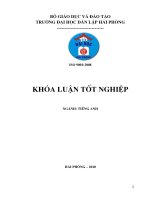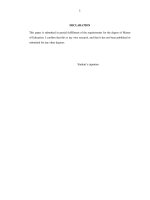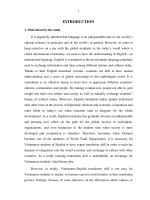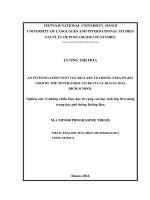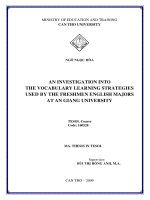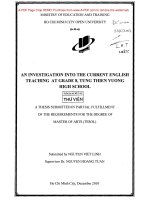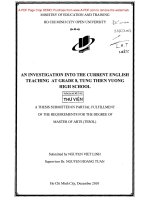An investigation into the vocabulary learning strategies used by the freshmen english majors at an giang university
Bạn đang xem bản rút gọn của tài liệu. Xem và tải ngay bản đầy đủ của tài liệu tại đây (725 KB, 109 trang )
MINISTRY OF EDUCATION AND TRAINING
CAN THO UNIVERSITY
NGÔ NGỌC HÒA
AN INVESTIGATION INTO
THE VOCABULARY LEARNING STRATEGIES
USED BY THE FRESHMEN ENGLISH MAJORS
AT AN GIANG UNIVERSITY
TESOL Course
Code: 160528
MA. THESIS IN TESOL
Supervisor:
BÙI THỊ HỒNG ANH, M.A.
CAN THO – 2009
DECLARATION
I hereby declare that the thesis titled “An Investigation into the Vocabulary
Learning Strategies Used by the Freshmen English majors at An Giang
University” represents my own work and that it has not been previously submitted
to any other university or institute in application for admission to a degree or other
qualifications.
_____________________________________________
September 2009
i
ACKNOWLEDGEMENT
Firstly, I would like to express my heartfelt gratitude to my supervisor, Ms. Bui
Thi Hong Anh for her continually invaluable guidance and encouragement
throughout the research. Without her support, the thesis could not have been
accomplished.
Secondly, I am indebted to the English-majored freshmen at An Giang University
for their willingness to participate in this study.
In addition, my great appreciation is also devoted to my academics at Can Tho
University for their committed instruction during the course.
Finally, many thanks go to my friends whose interest in this research was constant
sources of encouragement and confidence to me.
ii
TABLE OF CONTENTS
Declaration
i
Acknowledgement
ii
Table of Contents
iii
List of Tables
vii
List of Figures
viii
List of Abbreviations
ix
iii
Chapter 1: INTRODUCTION
1
1.1 Rationale
1
1.2 Research aims
3
1.3 Research questions
3
1.4 Research hypotheses
4
1.5 Significance of the study
4
1.6 Outline of the study
5
Chapter 2: LITERATURE REVIEW
6
2.1 Vocabulary and word
6
2.2 Knowing a word
8
2.2.1 Form
10
2.2.2 Meaning
10
2.2.3 Use
11
2. 3 Language learning strategies and vocabulary learning strategies
12
2.4 Classification of language learning strategies
15
2. 5 Schmitt’s (1997) taxonomy of vocabulary learning strategies
17
2.6 Research into vocabulary learning strategies
21
Chapter 3: METHODOLOGY
32
3.1 Research design
32
3.2 Subjects
33
3.3 Research Instruments
34
3.3.1 Vocabulary learning questionnaire
34
3.3.2 Vocabulary knowledge test
36
iv
3.3.3 Interview
37
3.4 Procedures of data collection
38
3.4.1 Questionnaire procedure
39
3.4.2 Test procedure
39
3.4.3 Interview procedure
40
3.4 Data analysis
40
Chapter 4: RESULTS
41
4.1 Research question 1
41
4.2 Research question 2
44
4.3 Research question 3
53
4.4 Research question 4
58
4.5 Summary of the results
59
Chapter 5: DISCUSIONS AND CONCLUSIONS
60
5.1 Discussions
60
5.1.1 Research question 1
60
5.1.2 Research question 2
64
5.1.3 Research question 3
69
5.1.4 Research question 4
70
5.2 Limitations
72
5.3 Pedagogical implications
73
5.4 Suggestion for further research
74
5.5 Conclusions
75
References
76
v
Appendices
81
Appendix 1: Test result
81
Appendix 2: Vocabulary learning questionnaire
83
Appendix 3a: Vocabulary knowledge test
87
Appendix 3b: Marking scheme
92
Appendix 4: Interview questions
94
Appendix 5: Descriptive statistics of the VLS questionnaire
95
Appendix 6: Descriptive statistics of the VLSs used by the four groups of achievers
97
Appendix 7: Descriptive statistics of the specific VLSs used by each group of achievers
98
vi
LIST OF TABLES
Table 2.1 General aspects of word knowledge
Table 2.2 Definitions of language learning strategies
Table 4.1 The mean scores for the five categories of VLSs
Table 4.2 One-Sample T-test of the often used VLSs among the freshmen
Table 4.3 The VLSs often used by the freshmen
Table 4.4 The VLSs often used by the four groups of achievers
Table 4.5 One-Sample T-test of the VLSs often used by very high achievers
Table 4.6 The VLSs often used by very high achievers
Table 4.7 One-Sample T-test of the VLSs used by fairly high achievers
Table 4.8 The VLSs often used by fairly achievers
Table 4.9 One-Sample T-test of the VLSs often used by medium achievers
Table 4.10 The VLSs often used by medium achievers
Table 4.11 One-Sample T-test of the VLSs often used by low achievers
Table 4.12 The VLSs often used by low achievers
Table 4.13 Pearson Correlation Matrix
vii
LIST OF FIGURES
Figure 2.1 Interrelationships between direct and indirect strategies among the six strategy
groups
Figure 5.1 The VLSs often used by the freshmen at An Giang University
Figure 5.2 The VLSs often used by very high achievers
Figure 5.3 The VLSs often used by fairly achievers
Figure 5.4 The VLSs often used by medium achievers
Figure 5.5 The VLSs often used by low achievers
viii
LIST OF ABBREVIATIONS
R: Receptive knowledge
P: Productive knowledge
L1: First Language
L2: Second Language
VLS: Vocabulary Learning Strategy
VLSs: Vocabulary Learning Strategies
Det: Determination Strategies
Soc: Social Strategies
Mem: Memory Strategies
Cog: Cognitive Strategies
Met: Metacognitive Strategies
EFL: English as Foreign Language
ESL: English as Second Language
ix
Chapter 1
INTRODUCTION
This chapter centers on the rationality of the study; the research aims; the
research questions; the research hypotheses; the significance and the outline of
the thesis.
1.1 Rationale
The researcher frequently bears in mind a question: “Why do many students at
An Giang University study the same syllabus under the same learning
conditions but they achieve very divergent results?” The researcher has tried
finding the answer to the question. For example, the researcher has considered
some of the learners‟ factors such as motivation; language aptitudes; attitudes;
learning styles; and time spent studying. After closely looking at those issues
through journals, research studies, books in the field of second language
acquisition, it is known to the researcher that these are not completely the
determinants of language learning. So what other factors could determine
students‟ achievement and failure in studying English? The answer could be
variations in learners‟ use of learning strategies.
In addition, the major goal of learning a language is to attain competence for
listening, speaking, reading and writing. Vocabulary plays an indispensable role
in every skill. The key to pursuing communicative competence is only by the
way of enlarging vocabulary. Therefore, vocabulary is the core of language and
plays very important role in language learning (Coady & Huckin, 1997).
Sharing Coady‟s and Huckin‟s view, Rubin and Thompson (1994) assures that
language learners are unable to communicate in their target language with a
small number of words and vocabulary is the central point of studying a
language. However, expanding vocabulary is not always easy for all language
learners without knowing and applying a variety of vocabulary learning
1
strategies because it is believed that “a large amount of vocabulary could be
acquired with the help of vocabulary learning strategies and that vocabulary
learning strategies have been proved useful for students of different language
levels.” (Nation 2001). Thus, it seems undeniable that “the success and failure
in learning a language could to a considerable extend be determined by
vocabulary and vocabulary learning strategies could not be separated from the
cultivation of language skills” (Gu, 1997).
Despite the importance of vocabulary and vocabulary learning strategies,
researchers have ignored them for years. Yet, a recently growing interest in
vocabulary and vocabulary learning strategies has led to a number of research
studies in this sub-category of second language acquisition including (e.g. Porte,
1988; Ahmed, 1989; Gu & Johnson, 1996; Lawson & Hogben, 1996; Schmitt,
1997; Kudo, 1999; Kojic-Sabo & Lightbown, 1999; and Fan, 2003). These
researchers targeted at examining the frequency of vocabulary learning strategy
use; the relationships between the use of vocabulary learning strategies and
language proficiency; and the vocabulary learning strategies of good and poor
learners. They found that there were several differences in the use of vocabulary
learning strategies between good and poor learners. Good learners inclined to
use larger numbers and more types of vocabulary learning strategies whereas
their poor counterparts applied limited numbers and fewer types of vocabulary
learning strategies. They also uncovered popular and unpopular vocabulary
learning strategies among Asian and non-Asian students as well. Those studies
have punctually been carried out in response to a gradual shift in the field of
second language study resulting less emphasis on teachers and teaching but
greater emphasis on learners and learning over the world. Nonetheless, much
research on second language study in Vietnam has hitherto centered up on
teachers and teaching especially in the domain of vocabulary learning and
vocabulary learning strategies. Research into teaching and learning English at
An Giang University is of no exception.
2
Taking all the above-mentioned issues into consideration, the researcher
determines to carry out “An investigation into the vocabulary learning strategies
used by the English-majored freshmen at An Giang University” with a strong
belief that it is impossible for teachers to help their students without knowing
how they actually study.
1.2 Research aims
The research is conducted to accomplish the subsequent aims. The first aim is to
find out the often used vocabulary learning strategies among the Englishmajored at An Giang University in general. Another aim is to discover whether
very high achievers, fairly achievers, medium achievers and low achievers
differ in their often used vocabulary learning strategies. One more aim is to see
if there are differences in the time spent studying vocabulary, the frequency of
reviewing vocabulary, the plan for vocabulary learning, and the sources of
vocabulary learning strategies among very high achievers, fairly high achievers,
medium achievers and low achievers. The final aim is to find out if there is a
correlation between the often used vocabulary learning strategies and students‟
scores in their vocabulary knowledge test.
1.3. Research questions
The study is set out to seek for the answers to the following questions:
(1) What vocabulary learning strategies do the English-majored freshmen at An
Giang University often use to study English words?
(2) Do very high achievers, fairly high achievers, medium achievers and low
achievers differ in their often used vocabulary learning strategies?
(3) Are there any differences in the amount of time spent studying vocabulary,
the frequency of reviewing vocabulary, the plan for vocabulary learning, and
the sources of vocabulary learning strategies among very high achievers, fairly
high achievers, medium achievers and low achievers?
(4) Is there a correlation between the often used vocabulary learning strategies
and students‟ scores in their vocabulary knowledge test?
3
1.4 Research hypotheses
The thesis intends to test the five following hypotheses:
Hypothesis 1
The English-majored freshmen at An Giang University could use the
vocabulary learning strategies under determination strategies, social strategies,
memory strategies and cognitive strategies to study English words.
Hypothesis 2
Very high achievers, fairly achievers, medium achievers and low achievers
could differ in quantities and types of their often used vocabulary learning
strategies.
Hypothesis 3
There could be differences in the amount of time spent studying vocabulary, the
frequency of reviewing vocabulary, the plan for vocabulary learning, and the
sources of vocabulary learning strategies among very high achievers, fairly high
achievers, medium achievers and low achievers.
Hypothesis 4
There could be a correlation between the often used vocabulary learning
strategies and students‟ scores in their vocabulary knowledge test.
1.5 Significance of the study
To begin with the idea that vocabulary learning strategies are a very essential
means for language learners to nurture their language skills, the present paper
describes and analyzes English learners‟ often used vocabulary learning
strategies. Besides, the researcher wants to find out if there are any differences
in the use of vocabulary learning strategies among very high achievers, fairly
high achievers, medium achievers and low achievers. In addition, the researcher
would prefer to find out whether there are differences the amount of time spent
studying vocabulary, the frequency of reviewing vocabulary, the plan for
vocabulary learning, and the sources of vocabulary learning strategies among
very high achievers, fairly high achievers, medium achievers and low achievers.
4
The researcher also finds out whether there is a correlation between the often
used vocabulary learning strategies and students‟ scores in their vocabulary
knowledge test. Although medium achievers and low achievers are unable copy
the strategies used by very high achievers and fairly high achievers, they could
reconsider their learning methods in order to select more suitable learning
strategies to their learning situations.
It is hoped that the findings of the study will contribute to vocabulary learning
and teaching. Additionally, the results could help raise awareness to both
language instructors and learners about the importance of vocabulary learning
strategies in acquiring English as a foreign language. Furthermore, the results
could prove that success in learning English does not only lie on teachers and
teaching but requires students‟ effort, responsibility and independent study.
Thus, students‟ learning outcomes possibly depend on how they study and how
they regulate their own learning process.
1.6 Outline of the study
This thesis is of the following parts. Chapter one addresses the rationale, the
research questions, the research aims, the hypothesis, the significance and
outline of the study. Chapter two introduces and establishes a conceptual and
theoretical framework on word and vocabulary, knowing a word, language
learning strategies and vocabulary learning strategies, the classification of
vocabulary learning strategies, the taxonomy of vocabulary learning strategies
as well reviews the studies related to the thesis. The next part, chapter three,
specifies research methods such as the research design, the subjects, the
research instruments, the data collection procedure and the data analysis.
Chapter four presents the quantitative and qualitative results. Chapter five
makes
mention
of
discussions,
limitations,
pedagogical
implications,
suggestions for further research and conclusions. Finally, the references and
appendices of study are provided.
5
Chapter 2
LITERATURE REVIEW
This chapter will mention vocabulary and word; knowing a word; language
learning strategies and vocabulary learning strategies; classification of language
learning strategies; taxonomy of vocabulary learning strategies; and finally
research into vocabulary learning strategies.
2.1. Vocabulary and word
Vocabulary is basically defined as “all the words of a language” (Webster‟s
dictionary, 1996: 1494). Accordingly, there is active and passive vocabulary in
a language. Active vocabulary is all the words used by a particular person. In
contrast, passive vocabulary is all the words recognized and understood,
although not necessarily used by a particular person. In other words, active
vocabulary is words that a particular person uses in spoken and written form
whereas passive vocabulary is words that a particular person understands upon
listening and reading. However, one question that emerges from the definition
of vocabulary is “What is a word?” Linguists have presented several definitions
of word. The complexity of defining a word resulted in a conclusion that “word
is characterized by different, often contradictory traits depending on the
theoretical background and descriptive context” (Bussmann, 1998). In the
following paragraphs, typical definitions of word from different perspectives
will be addressed.
In terms of orthography, a word is regarded as “any sequence of letters and a
limited number of other characteristics such as hyphen and apostrophe bounded
on either side by a space or punctual mark” (Carter, 1998:4). This definition has
been criticized for being formalistic, inconsistency and incompleteness due to
the fact that the differences in meaning and the issues of polysemy, homonymy
and grammatical functions are disregarded (Takac, 2008:5). In fact, in English,
6
homonymy and polysemy are quite common. Words such as bear- bear; see see; or stand - stand are alike in forms but very dissimilar in their meanings. For
grammatical functions, a verb usually has several forms due to their functions in
sentences for example go - went - gone; take - took – taken. Should homonymy,
polysemy and words with different grammar functions be considered one word
or several words? Thereby, this definition does not seem to work well with
polysemy, homonym as well as words with different grammatical forms.
In reference to semantics, a word is defined as “the smallest meaningful unit of
language” (Carter, 1998). Nonetheless, it is not a clear definition of what
meaning is (i.e. what the relationship between the linguistic sign is and what it
denotes outside the language). Takac (2008:5) continues that namely some units
of meaning consist of several words (e.g. bus conductor, for some the meaning
cannot be determined without looking into their function of structuring and
organizing information (e.g. if, but) and certain integral parts of words cannot
stand on their own even if one knows their meaning (e.g. the prefix 're'- in
retell). Thus, it is not a completely satisfactory definition of word.
Morphologically, “A word is a minimal free form”. It means that “a word is a
word if it can stand on its own as reply to a question or a statement or
exclamation” (Carter, 1998:5). This definition could not be complete in
regarding to conjunctions (e.g. but, or, and, yet, or so). They only stand alone in
a dictionary but they are likely to go with other words in spoken and written
sentences.
In the view of lexical-semantics, “A word is the minimum meaningful unit of
language” (Carter, 1998: 5). According to this definition, one word has only one
meaning. This definition is critiqued for two reasons. First, it does not fully
apply to words with several meanings or polysemy. Second, it seems
inapplicable to “a string of words taken together has a different meaning than
the combination of the individual component words” or an idiom (Schmitt,
2000:1).
7
Evidently, it is uneasy to find a universally acknowledgeable and accurate
definition of word. To avoid these problems, it is suggested that the term word
be substituted by the term lexeme or lexical item because it is argued that
lexeme is “the smallest unit in the meaning system of a language that can be
distinguished from other similar units. A lexeme is an abstract unit. It can occur
in many different forms in actual spoken or written sentences, and is regarded
as the lexeme even when inflected” (Richards & Schmitt, 2002: 303). In this
paper, the terms word and vocabulary are used interchangeably as Carter (1998)
points out that “it is clear that the uses of the words or vocabulary have general
common-sense validity and are serviceable when there is no need to be precise.”
(Carter, 1998:8). So, a word is employed in this thesis with a general common
sense: “A word is the minimum meaningful unit of language” (Carter, 1998:5).
One question arises from the definitions of word is “What does knowing a word
mean?” The question will be answered in the following lines.
2. 2 Knowing a word
It is commonly thought that knowing a word simply knows its meaning.
Therefore, many Vietnamese learners of English often study meanings of words
by translating them into their mother tongue. They happen to ignore word‟s
spelling, pronunciation, grammar and other aspects of word knowledge. For this
reason, they are incapable of pronouncing, writing them well and applying them
in appropriate contexts. The difficulty reveals that knowing a word requires
learners to know more aspects of word knowledge rather than merely its
meaning.
Linguists have presented a number of definitions of knowing a word but
different authors have distinct opinions about “what does knowing a word
mean?” which reflects the authors‟ background knowledge of the concerned
topic. In this section, certain views on knowing a word will be considered.
8
McCarthy and O‟Dell (2001:5) make some suggested guidelines for knowing a
word. It is insufficient to just know the meaning of a word. It is also necessary
to know its collocations; its distinctive syntactical features; and its
pronunciation. In addition, other aspects including its degree of formality,
informality or neutrality should be discerned (McCarthy & O‟Dell 2001: p.5).
More detailed than McCarthy‟s and O‟Dell‟s criteria of knowing a word, Nation
(2001:24) makes an apparent distinction between receptive and productive
knowledge of a word (see table 2.1).
Table 2.1. General aspects of word knowledge (Nation, 2001:27)
Form
Spoken
written
word parts
R What does the word sounds like?
P How is the word pronounced?
R What does the word look like?
P How is the word written and spelled?
R What parts are recognizable in this word?
P What word parts are needed to express the meaning?
Meaning
Form and meaning
R What meaning does this word form signal?
P What word form can be used to express this
Concept and referents meaning?
R What is included in the concept?
P What items can the concept refer to?
Associations
R What other words does this word make us think of?
P What other words could we use instead of this one?
Use
Grammatical
functions
Collocations
Constraints on use
R = receptive knowledge
R In what patterns does this word occur?
P In what patterns must we use this word?
R What words or types of words occur with this one?
P What words or type of words must we use with this
one?
R Where, when, and how often would we expect to
meet this word?
P Where, when, and how often can we use this word?
P = productive knowledge
The ability to understand a word when reading or listening is termed receptive
or passive knowledge. Contrastingly, productive or active knowledge is
associated with the ability to produce a word in speaking and writing. This
9
classification of word knowledge bears a resemblance to the distinction between
receptive skills of listening and reading and the productive skills of speaking
and writing. In line with productive and receptive skills, three fundamental
criteria of knowing are suggested involving: knowing its form, its meaning and
its use (Nation 2001:27). Every criterion comprises separated aspects but they
are closely interwoven with each other. The three major terms form, meaning
use and their subcomponents will be dissected below.
2.2.1 Form
The term form not only makes reference to spoken but also written form of a
word. Knowing the form is known as the ability to recognize the word through
reading and listening and the ability to pronounce the word accurately with
stress and write it with correct orthography.
Word parts deal with the ability to realize the components forming a word and
associate them to the word meaning, for example, upon encountering the words
overrate, overemphasize and overexcite, students can discover that the words
are composed of over- rate, over - emphasize and over - excite and can link
these parts with their meanings. The ability to realize the link between word
parts and the word‟s meaning is very essential in language learning since it is
ascertained that learners‟ knowledge of word‟s parts and how the parts are built
together changes as their proficiency develops (Nation, 2001).
2.2.2 Meaning
In addition to knowing the form of a word, it is crucial to know how to connect
form and meaning of a word. Baddeley (1990) assures that the strength of
connection between the form and its meaning influences the retrieval of the
meaning when seeing or hearing it.
Concerning about word‟s concept and referent, it is claimed that the relationship
between the two is not always one to one. Words have various meanings. Words
have the same form but convey unconnected meanings are referred to as
10
homonyms (e.g. book – book, see – see). Occasionally, words have the same
form and they are closely related in their meaning are said to be polysemy for
example, the noun head as a person‟s head and as the head of a department
(Nation, 2001:49). Coping with homonyms and polysemous items well, it is
magnitudinous to be aware of the concept behind the word, understanding the
word meanings well in different contexts, and knowing how to produce the
words in a variety of contexts.
As far as knowing the associations of word is concerned, associations indicate
the relationships between words, such as synonymy (words with different forms
with the same or nearly similar in meaning e.g. handsome and good-looking),
antonymy (words with opposite meaning e.g., good and bad), and hyponymy
(the hierarchical relationship between words e.g., bird is hyperonym, a lark is
the hyponym). It is affirmed that understanding these relations is helpful for
explaining the meaning of word and developing tasks to deepen learner‟s
understanding of words (Nation, 2001: 52).
2.2.3 Use
To be able to use the word accurately, it is needed to have the knowledge of the
form and the meaning as well as the knowledge of grammatical functions
involving knowing the part of speech of the word and what grammatical
patterns can it be put in, for example, some Vietnamese English learners write a
sentence: “I very like my class”. The example shows students‟ incomplete
understanding of English language structure. They know the form and meaning
of the word “like” but they do not really know its part of speech; so they put it
in a wrong pattern.
The way in which words are regularly used together is referred to as
collocations involving the restrictions on how we use words together, for
example which prepositions usually go with a particular verb or which verbs
and nouns usually go together. For example in English the adjective high and
11
low frequently go with the noun salary but not with good and bad; the verb do
often goes the noun homework – do one‟s homework but not make one‟s home
work (Richards & Schmidt, 2002: 87).
Apart from those aspects of word knowledge, knowing the constraint on use
plays very important role in teaching and learning vocabulary. This aspect of
word knowledge includes knowing whether the word is high or low frequency
and knowing how to use the word properly. Nation (2001:57) stresses the
importance of knowing the frequency constraint by stating that “if a teacher
spends a lot of time on a word and overuses it, this affects the learner‟s use of
this word. If time is given to words according to their usefulness, then this can
be avoided” (Nation, 2001:57). The appropriateness of word use is sometimes
contingent upon culture. Nation (2001: 58) concludes that constraint on use can
not be similar across cultures. Some words are appropriate in this culture but
inappropriate in another as “in Thai, names like pig, fatty, shrimp and mouse
are common nicknames. They are less acceptable in English.”
Overall, to be capable of knowing and using a word well, it principally requires
being knowledgeable of form, meaning and use but the other aspects of word
knowledge underlying these criteria are not supposed to be ignored. In
comparison with McCarthy‟s & O‟Dell‟s (2001), Nation‟s (2001) definition of
knowing a word seems more specific and comprehensible. The researcher is in
support of Nation‟s criteria of knowing a word. Thereupon, this paper is based
on Nation‟s (2001) suggested criteria of knowing a word.
2.3. Language learning strategies and vocabulary learning strategies
The present study is conducted to scrutinize the English learners‟ vocabulary
learning strategies. Vocabulary learning strategies are subcomponents of
language learning strategies. Hence, the researcher reviews definitions of
learning strategies and draws a definition of vocabulary learning strategy for the
study.
12
The term strategy whose meaning was described as carefully designed plans for
military operations primarily originated from military science (Oxford, 1990).
Nowadays, the term strategy has become increasing popular in many spheres of
human lives as in commerce, politics, and diplomacy and in education as well.
Generally in education, strategies are set of deliberate plans and operations a
learner employs to facilitate learning processes and to improve learning results
(Gu, 1997: p.4). Besides the term strategy, the terms tactics and techniques are
often found in language learning context. Learning strategies are conceptualized
as learner‟s general approaches to learning while tactics and techniques refer to
specific actions used to achieve a specific goal. Tactics are observable actions
implying the use of a certain strategy (Schmeck, 1988:171), for example, when
a learner infers a word‟s meaning by remembering another word that sounds
similar, he or she uses the strategy of inferencing (Goh, 1998: 125). Takac
(2008: 47) remarks, “Currently researchers have abandoned the dichotomy
between strategies and tactics or techniques and use the term individual learning
strategy to refer to the kind of behavior Stern called techniques”. In second
language study, although authors have done research on language learning
strategies, they have not been able to present a commonly agreed definition of
language learning strategy. Some typical definitions of vocabulary learning
strategies are summarized in table 2.2 below.
13
Table 2.2 Definition of vocabulary learning strategies (Takac, 2008:51)
Source
Tarone (1981)
Rubin (1987)
Chamot (1987)
Definition
An attempt to develop linguistic and sociolinguistic competence in the
target language.
What learners do to learn and do to regulate their learning.
Techniques, approaches or deliberate actions that students take in order
to facilitate learning, recall of both linguistic and content information.
The term refers to language behaviors learners engage in to learn and
Wenden (1987)
regulate the learning of L2, to what learners know about the strategies
they use (i.e. strategic knowledge), and to what learner know about
aspects of L2 learning.
Weinstein and
Behaviors and thoughts that a learner engages in during learning that are
Mayer (1996)
intended to influence the learner‟s encoding process.
Oxford (1990)
Behaviors or actions which learners use to make language learning more
successful, self-directed and enjoyable.
Ellis (1995)
Generally, a strategy is mental or behavioral activities related to some
specific stages in the process of language acquisition or language use.
Broadly speaking, the term strategy denotes procedures – which are
Ridley (1997)
sometimes conscious and sometimes unconscious – used by a person as
a way of recalling of reaching a goal.
Processes which are consciously selected by learners and which may
Cohen (1998)
result in actions taken to enhance the learning or use of an L2, through
the storage, recall and application of information about that language.
Purpura (1999)
Conscious or unconscious techniques or activities that an individual
invokes in language learning, use or testing.
As shown in table 2.2, there seem to be rather many definitions of language
learning strategies. One feature of language learning strategies which could
cause controversy among the definitions in table 2.2 is concept of consciousness
and unconsciousness of language learning strategies. With respect to
14
consciousness of language learning strategies, Takac (2008: 55) argues that the
issue of consciousness of language learning strategies is still very much
controverted. Language learners often utilize their learning strategies
deliberately and consciously but when they can use them automatically, they
can use them without consciousness. Thus, Takac (2008:.55) maintains that
“Many researchers agree, however, that language learning strategies are often
used deliberately and consciously, but their use can become automatic, that is,
subconscious. It can be concluded that language learning strategies are
conscious, potentially conscious or subconscious depending on individual
learners and the task they are engaged in”.
In view all the definitions, in this paper language learning strategies are
“specific intellectual or physical actions, behaviors, steps, techniques or
methods that language learners regularly engage in either consciously or
subconsciously to facilitate their learning process and improve their competence
in the target language”. Correspondingly, vocabulary learning strategies are
“specific intellectual or physical actions, behaviors, steps, techniques or
methods that learners regularly engage in either consciously or subconsciously
to facilitate and improve both the efficacy of vocabulary learning and use in the
target language”.
2.4. Classification of language learning strategies
According to O‟Malley and Chamot‟s (1990), language learning strategies are
divided into three categories including metacognitive, cognitive and social /
affective strategies. Metacognitive strategies provide an overview of language
use and learning as well as the procedure for planning and regulating learning
and using a language effectively while cognitive strategies are related to the
process of manipulating information through an instant task with a view to
obtaining and storing the information. Finally, social strategies are involved in
acquiring and retaining a language with the help of interacting socially and
15
